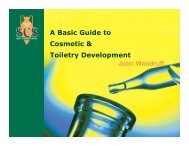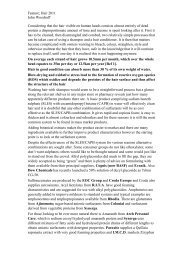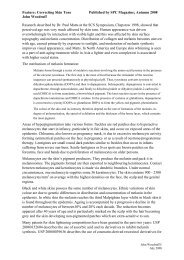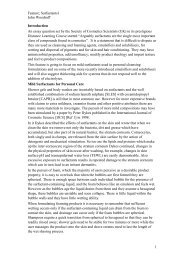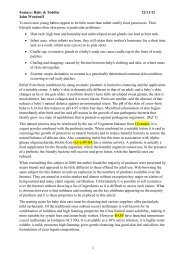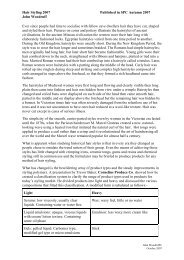Silicones and alternatives.pdf - Creative Developments
Silicones and alternatives.pdf - Creative Developments
Silicones and alternatives.pdf - Creative Developments
You also want an ePaper? Increase the reach of your titles
YUMPU automatically turns print PDFs into web optimized ePapers that Google loves.
Feature; <strong>Silicones</strong> <strong>and</strong> silicone <strong>alternatives</strong><br />
John Woodruff<br />
When silicones were first offered as ingredients for cosmetic products about 50m<br />
years ago they were the inert dimethicones or so-called silicone oils. Their principal<br />
function was as replacement materials for hydrocarbon oils <strong>and</strong> for imparting waterresistance<br />
to barrier creams. Their molecular weight is controlled by the number of O-<br />
Si groups in the molecule, <strong>and</strong> their viscosity ranges from 0.65cst to 1,000,000cst.<br />
The higher molecular weight dimethicones are often mixed with cyclomethicones to<br />
form so-called silicone gums, which have wide applications in hair care.<br />
<strong>Silicones</strong> are polymers that include silicon together with carbon, hydrogen, oxygen,<br />
<strong>and</strong> sometimes other chemical elements. By a process termed hydrosilylation it is<br />
possible to form a Si-H bond, which can then be reacted with a terminal double bond,<br />
resulting in a stable Si-C bond. This gives rise to important groups of silicone<br />
compounds including alkyl silicones, fluoro silicones, PEG/PPG products <strong>and</strong><br />
copolymer resins by a process known as functionalisation. These materials may then<br />
be derivatised to provide esters, phosphate esters sulfosuccinates, sorbitan esters,<br />
sulphates <strong>and</strong> carboxylates.<br />
Modified silicones include the addition of perfuoro groups to increase spreading<br />
properties <strong>and</strong> of alkyl groups to improve substantivity <strong>and</strong> wet combing <strong>and</strong> to<br />
impart a velvety feel in skin creams. Aryl <strong>and</strong> phenyl groups give added gloss to hair<br />
<strong>and</strong> improve organic compatibility <strong>and</strong> polyether <strong>and</strong> glucoside groups provide<br />
emulsifiers, conditioning properties <strong>and</strong> foam boosting activity.<br />
Silicone waxes are of interest to formulators. Their melting point depends on their<br />
molecular structure <strong>and</strong> varies from a soft gel to a high melting point wax. When<br />
incorporated into emulsions they lower the surface tension of the oil phase <strong>and</strong> thus<br />
improve its spreading properties <strong>and</strong> they can also be added to shampoos to add<br />
conditioning properties.<br />
<strong>Silicones</strong> are driving innovation in personal care <strong>and</strong> allowing product differentiation<br />
based on performance. That statement was made by Claudius Schwarzwalder, Centre<br />
Européen des <strong>Silicones</strong>, at In-Cosmetics 2006 <strong>and</strong> it is hard to imagine cosmetic<br />
compositions without them.<br />
Current developments in silicone technology include combining basic silicone<br />
structures with organic moieties to create new hybrid materials. This is providing<br />
silicone resin gels <strong>and</strong> powders, new hyper-branched structures <strong>and</strong> materials such as<br />
silicone-polyethers for thermal protection of hair <strong>and</strong> thermoplastic silicone<br />
elastomers as film formers <strong>and</strong> fixatives. Future developments are expected to provide<br />
silicone-based delivery systems for bioactive compounds for controlled release,<br />
biologically active silicone compounds <strong>and</strong> enzymatic silicon-carbon bond formation.<br />
One group of silicone compounds that found wide-spread acceptance were the<br />
cyclomethicones with D4, cyclotetrasiloxane, <strong>and</strong> D5 or cyclopentasiloxane proving<br />
the most useful. Because cyclomethicones are volatile they require careful h<strong>and</strong>ling<br />
but once incorporated in an emulsion they improve its spreading properties, eliminate<br />
soaping <strong>and</strong> give a dry, silky skin feel. Unfortunately the use of cyclomethicones was<br />
queried by Canadian authorities <strong>and</strong> then under REACH <strong>and</strong> there was a real risk that<br />
its use in cosmetic products would be banned.
Feature; <strong>Silicones</strong> <strong>and</strong> silicone <strong>alternatives</strong><br />
John Woodruff<br />
This spurred many ingredient suppliers to find alternative non-silicone materials that<br />
could be substituted for D4/D5 but in late October 2011 the Canadian Board of<br />
Review for Cyclopentasiloxane in the Environment released the following statement:<br />
“The Board conducted a scientifically rigorous review of all the relevant scientific<br />
information related to our m<strong>and</strong>ate. Taking into account that information, the Board<br />
has concluded that Siloxane D5 does not pose a danger to the environment or its<br />
biological diversity. Furthermore, the Board concluded that, based on the information<br />
presented, Siloxane D5 will not pose a danger to the environment or its biological<br />
diversity in the future” On receipt of this statement the CTPA placed on its web site<br />
its own statement: “This reaffirms the position of the European cosmetics industry<br />
that the option of no regulatory action for the siloxanes, in the EU under REACH, is<br />
the most appropriate”<br />
Dow Corning is a name synonymous with silicone technology <strong>and</strong> it offers an<br />
outst<strong>and</strong>ing range of materials for cosmetics <strong>and</strong> personal care products. Its own<br />
statement on the matter reads “Based on more than 300 scientific studies, Dow<br />
Corning continues to believe that products containing D4<strong>and</strong> D5 are safe for human<br />
health <strong>and</strong> the environment when used in accordance with accepted health <strong>and</strong> safety<br />
principles”.<br />
During the period of uncertainty leading up to these pronouncements many ingredient<br />
suppliers have been looking into their portfolio of materials to identify possible<br />
<strong>alternatives</strong> <strong>and</strong> formulators most probably have not been including D4/D5 into new<br />
formulations. In addition products made to Ecocert or Soil Association st<strong>and</strong>ards for<br />
natural <strong>and</strong> organic cosmetics cannot include silicone materials so there remains a<br />
market for <strong>alternatives</strong>. The properties of D4/D5 that need to be considered when<br />
seeking replacements are their volatility <strong>and</strong> extremely low surface tension, which<br />
substantially contributes to their sensorial properties.<br />
Because the use of D4 was the first cyclomethicone to be queried <strong>and</strong> the more likely<br />
to be banned D5 has become the more popular <strong>and</strong> it is the one for which other<br />
materials are being offered as replacements. LuxVeil 5 from Arch Personal Care is a<br />
mixture of isododecane <strong>and</strong> PPG-3 myristyl ether neoheptanoate with a low viscosity<br />
<strong>and</strong> high volatility profile. It is claimed to deliver the same feel <strong>and</strong> performance as<br />
cyclopentasiloxane, quickly evaporating from the skin, leaving a soft, luxurious skin<br />
feel.<br />
A rather more complicated mixture of isododecane, hydrogenated polydecane <strong>and</strong><br />
Bis-behenyl/isostearyl/phytostearyl dimerdillnoleyl dimmer dillinoate under the trade<br />
name Lipo SFS-5 is offered by Lipo. It is claimed to provide the same performance<br />
characteristics as cyclopentasiloxane but without the drying <strong>and</strong> whitening effects on<br />
application <strong>and</strong> it will also mask the whitening effect of antiperspirants on skin <strong>and</strong><br />
clothing.<br />
It is unlikely that either of these materials will gain acceptance by Ecocert so the<br />
simpler expedient of using Neolight 180P from Kokyo Alcohol Kogyo may be<br />
preferable. This is isostearyl neopentanoate, which is claimed to be a dry <strong>and</strong> non-oily<br />
emollient, with low viscosity <strong>and</strong> low solidification point. It has good affinity to<br />
powders, resists hydrolysis due to its neo-structure <strong>and</strong> may be used as a sensorial<br />
replacement of cyclopentasiloxane.
Feature; <strong>Silicones</strong> <strong>and</strong> silicone <strong>alternatives</strong><br />
John Woodruff<br />
BRB International offers low viscosity dimethicones with excellent spreading, easy<br />
rub-out <strong>and</strong> lubrication properties together with unique volatility characteristics as<br />
<strong>alternatives</strong> to cyclomethicones. A&E Connock suggests the use of its<br />
Hexamethyldisiloxane V0.65, which has many properties similar to D5 as regards<br />
volatility, sensorial properties <strong>and</strong> suppression of soaping up of emulsions.<br />
Dermal Esters from Alzo International is a mixture of isodecyl isononoate <strong>and</strong><br />
ethylhexyl isononoate with quick drying properties <strong>and</strong> a similar skin feel to D5. Alzo<br />
also suggests its Beantree [INCI: Methylheptyl isostearate], which is a low molecular<br />
weight double branched ester with a dry skin feel that is EcoCert approved to replace<br />
silicones in natural products.<br />
With Ecocert approval DUB Zenoat from Stearinerie Dubois is propanediol<br />
dicaprylate <strong>and</strong> is entirely derived from vegetable <strong>and</strong> renewable raw materials. It is a<br />
colourless <strong>and</strong> odourless ester with excellent spreading properties <strong>and</strong> a non greasy,<br />
satin-smooth feel. It also has very good solubilising properties making it a vegetable<br />
alternative to cyclomethicones, isohexadecane, <strong>and</strong> liquid paraffin <strong>and</strong> propylene<br />
glycol esters.<br />
Stearinerie Dubois also supply isodecyl neopentanoate under the trade name DUB<br />
VCI 10 <strong>and</strong> describe it as the lightest ester in the Dubois range. It has a very low<br />
viscosity <strong>and</strong> excellent spreading properties thanks to its very short <strong>and</strong> branched<br />
chains, which allows a good miscibility with silicones, especially dimethicones <strong>and</strong><br />
silicone elastomers. The same material is available from Lubrizol as Schercemol 105<br />
Ester <strong>and</strong> Lubrizol have an extensive range of esters, some of which may be<br />
considered if seeking to replace cyclomethicone or dimethicone in formulations. Of<br />
particular interest may be neopentyl glycol diethylhexanoate, diisopropyl sebacate <strong>and</strong><br />
diisopropyl adipate, used alone or in combination.<br />
Inolex provide two variations of a mixture of neopentyl glycol diheptanoate <strong>and</strong><br />
isododecane that mimic the properties of volatile silicone emollients in personal care<br />
products. They are trade named Lexfeel D4 <strong>and</strong> Lexfeel D5 <strong>and</strong> are described as<br />
highly purified, light dry fluids. Sasol has Parafol 12-97 [INCI: Dodecane] <strong>and</strong><br />
Parafol 14-97 [INCI: Tetradecane] described as naturally derived hydrocarbons with a<br />
very light skin feel. From Floratech there is Floramac 10 [INCI: Ethyl macadamiate],<br />
which is another offering suggested as a suitable substitute for D4/D5. It is a dry<br />
emollient derived from macadamia nut oil, which provides skin feel similar to many<br />
silicones <strong>and</strong> silicone derivatives. Floramac 10 is plant-derived, non-volatile, <strong>and</strong><br />
unlike many synthetics it has broad coupling <strong>and</strong> solubility characteristics. Its slip <strong>and</strong><br />
spreadability characteristics are similar to isopropyl myristate <strong>and</strong> isopropyl palmitate<br />
<strong>and</strong> it is a good solvent for organic sunscreens.<br />
Essa Technologies markets an ester based on olive oil named Essachem [INCI:<br />
Octyldodecyl olivate], which although lacking the volatility of D4/D5, it has similar<br />
light <strong>and</strong> fast spreading properties <strong>and</strong> imparts a soft smooth after feel on skin. Also<br />
based on olive oil, Softolive from Soliance is a mixture of hydrogenated ethylhexyl<br />
olivate <strong>and</strong> hydrogenated olive oil unsaponifiables. It is described as a highly stable<br />
olive-based emollient with an elegant, dry skin feel, which is of interest if seeking a<br />
replacement for a fluid dimethicone.
Feature; <strong>Silicones</strong> <strong>and</strong> silicone <strong>alternatives</strong><br />
John Woodruff<br />
Active Shine Amazon from Chemyunion is described as a natural sensory modifier<br />
for hair <strong>and</strong> is a vegetable source alternative to silicone as it provides a similar feel<br />
<strong>and</strong> properties to hair [INCI: Orbignya speciosa (Babassu palm) kernel oil,<br />
Astrocaryum murumuru (palm) seed butter].Creations Couleurs has a range of<br />
materials under the heading Dedraflow 5X based on hydrogenated polyisobutene that<br />
are designed to replace D4/D5 in cosmetic <strong>and</strong> personal care products. They are said<br />
to have the same skin feel as cyclomethicone <strong>and</strong> their volatility profile is very similar<br />
<strong>and</strong> it is claimed that they can be used to replace cyclomethicone without any further<br />
modifications in the formulation to deliver the same feel <strong>and</strong> performance.<br />
Not content with suppliers claims Jennifer Allen of Cornelius Technical, Quality<br />
<strong>and</strong> Regulatory Department undertook her own investigation to compare the<br />
principal properties of cyclopentasiloxane with suggested <strong>alternatives</strong>. Parameters<br />
tested were spreadability, slip, dry feel, skin penetration <strong>and</strong> after feel. Each material<br />
performed well in at least one test <strong>and</strong> it was determined that BASF's Luvitol Lite<br />
[Hydrogenated polyisobutene]. is a close match to cyclopentasiloxane for slip <strong>and</strong> dry<br />
skin feel <strong>and</strong> is also quite close in regards to after feel. A combination of Pelemol 89<br />
[INCI Ethylhexyl isononanoate] <strong>and</strong> Jeesilc PS-PTLV [INCI: Phenyl trimethicone,<br />
Bis-vinyl dimethicone/dimethicone copolymer] from Jeen, performed the best in the<br />
spreadability coefficient test plus the mixture gave very close results in the after feel<br />
test <strong>and</strong> is the closest match for skin penetration with good dry feel properties. The<br />
full report is available from jja@cornulius.co.uk<br />
As may be expected, some of the larger suppliers have made their own studies into<br />
silicone replacements <strong>and</strong> have published suggested <strong>alternatives</strong>. Cognis have<br />
published a brochure [Ref 1] on the subject <strong>and</strong> suggest short chain esters, carbonates<br />
<strong>and</strong> ethers that offer the lightness of cyclic silicone in silicone-free leave-on products.<br />
Of these Cetiol C5 [INCI: Coco-caprylate] is said to be the nearest alternative to D5.<br />
It is said to match the sensorial profile of cyclomethicone; comes from 100 % natural,<br />
renewable feedstock, has good skin compatibility <strong>and</strong> good wetting ability for<br />
powders.<br />
Cetiol CC [INCI: Dicaprylyl carbonate] is offered as a dry emollient <strong>and</strong> is claimed to<br />
provide a dry, velvety <strong>and</strong> smooth skin feel similar to some silicones. It is a good<br />
solvent for UV filters <strong>and</strong> shows improved make-up remover efficacy in facial<br />
cleansing lotions. Photomicrographs show superior dispersion of micronised titanium<br />
dioxide in emulsions compared to D5. Other suggestions are Sensoft [INCI:<br />
Propylheptyl caprylate] for its luxurious, silky <strong>and</strong> velvety skin feel <strong>and</strong> Cetiol OE<br />
[INCI: Dicaprylyl ether] for its light, silky skin feel <strong>and</strong> is especially suitable for<br />
antiperspirant applications because of it stability at extremes of pH.<br />
Even companies that are primarily silicone suppliers have looked at possible D5<br />
replacements. Siltech suggest Silwax DO2 [INCI: Ethyl methicone] that can be<br />
used in conjunction with a vegetable oil <strong>and</strong> only 2% to 4% changes the feel of the<br />
vegetable oil to give a dry silky emolliancy remarkably similar to cyclomethicone. If<br />
no silicones can be used then Siltech offers a range of natural polymers based on<br />
citrate polyesters, which can be used as silicone replacements giving similar spread<br />
slip feel <strong>and</strong> gloss. One example is Cosmosurf 150 [INCI: Octyl dodecyl citrate<br />
crosspolymer], which is alcohol soluble, <strong>and</strong> described as a multi-domain ester.
Feature; <strong>Silicones</strong> <strong>and</strong> silicone <strong>alternatives</strong><br />
John Woodruff<br />
Dow Corning suggests investigating the properties of a linear volatile dimethicone<br />
with viscosity of 2cs to replace the volatile <strong>and</strong> sensory properties of D4 <strong>and</strong> D5 or<br />
dimethicones up to 20cs for their sensorial properties. Newly launched by Dow<br />
Corning is DC CB 1502 Gum Organic Blend, a mixture of C11-13 isoparaffin,<br />
isohexadecane, dimethiconol <strong>and</strong> dimethicone that is specifically designed for<br />
anhydrous hair serums where volatility is crucial <strong>and</strong> when cyclomethicones are to be<br />
avoided.<br />
<strong>Silicones</strong> also find applications in body washes, shampoos <strong>and</strong> hair conditioners <strong>and</strong><br />
the Cognis brochure has many ideas to provide the sensory or conditioning<br />
performance that consumers expect <strong>and</strong> require from such products if they are to be<br />
successful replacements.<br />
However efficacious materials are in their own right if they are to be viewed as<br />
possible <strong>alternatives</strong> to achieve a particular effect in a formulation none are likely to<br />
be direct replacements in existing formulations. Their introduction as substitutes is<br />
going to require an in-depth study of the entire formulation. Volatile siloxanes have<br />
been the principal silicone materials of concern <strong>and</strong> the emphasis has been on their<br />
replacement. Meanwhile mainstream cosmetic products have continued to use the<br />
most suitable materials available for a particular purpose, <strong>and</strong> in very many cases this<br />
has meant the use of silicone-based materials.<br />
The safety of silicone compounds is well established <strong>and</strong> the CTFA CIR [REF 2]<br />
report states that silicone compounds do not readily cross membrane barriers <strong>and</strong> are<br />
not absorbed through the skin. They are not metabolised by the body or by microorganisms<br />
<strong>and</strong> are relatively innocuous when administered orally or parentally.<br />
The list of silicone compounds in current use appears almost endless <strong>and</strong> it is difficult<br />
to suggest what may be the most suitable for any particular product category.<br />
Exsymol lists twenty-four silanols, which are organic derivatives of silicone, rich in<br />
hydroxyl functions <strong>and</strong> synthesised in the presence of different radicals. They possess<br />
unique biological properties, enhanced or modulated by the presence of these radicals.<br />
Examples are silanediol salicylate; dimethylsilanol hyaluronate, silanetriol trehalose<br />
ether <strong>and</strong> polysilicone 3, which has an affinity for keratin-type proteins <strong>and</strong> improves<br />
cutaneous moisture levels <strong>and</strong> stimulates hair <strong>and</strong> nail growth.<br />
Biosil Technologies Inc. lists thirty-nine silicone compounds for cosmetics <strong>and</strong><br />
personal care including fourteen speciality compounds. For hair care there are five<br />
ingredients formed by the reaction of a silicone <strong>and</strong> an amino acid such as<br />
dimethiconol panthenol, trade-named Biosil Basics DL-30. It is a water dispersible<br />
silicone formed by reacting DL-panthenol with a highly reactive silicone. Other<br />
examples are dimethiconol arginine, dimethiconol methionine <strong>and</strong> dimethiconol<br />
cysteine. Cysteine, with its thiol group, is able to create disulfide bridges <strong>and</strong><br />
dimethiconol cysteine increases hair volume <strong>and</strong> provides excellent conditioning for<br />
damaged hair. There are other silicone compounds for skin care, sun protection<br />
products <strong>and</strong> decorative cosmetics [Ref 3].<br />
A&E Connock lists even more silicone mixtures <strong>and</strong> compounds <strong>and</strong> its web site has<br />
an interesting article, which although a little out of date, it explains why silicones are<br />
such popular additives to cosmetic applications [Ref 4]. Unlike the majority of<br />
suppliers A&E Connock sells materials by their INCI designations <strong>and</strong> they are
Feature; <strong>Silicones</strong> <strong>and</strong> silicone <strong>alternatives</strong><br />
John Woodruff<br />
obtained from carefully selected manufacturers worldwide. Its web site lists all<br />
silicones of major interest including dimethicones with viscosities from 1cs to<br />
1,000,000; phenyl trimethicone with its outst<strong>and</strong>ing glossing properties <strong>and</strong><br />
polysilicone-18 cetyl phosphate that is used in conditioners to protect hair colour <strong>and</strong><br />
in sprays for thermal protection.<br />
Silicone materials are of particular importance in hair conditioning; Clariant offers<br />
Silcare Silicone SEA [INCI: Trideceth-9 amodimethicone, trideceth-12]. It is a selfemulsifying<br />
aminosiloxane that is soluble in water <strong>and</strong> at 2% in alcohol. It can give<br />
clear solutions in shampoos <strong>and</strong> conditioners <strong>and</strong> is particularly recommended for use<br />
in colour protection compositions. Amodimethicones may also be used in skin care<br />
<strong>and</strong> Clariant suggests Silcare Silicone WSI [INCI: Amodimethicone<br />
glycerocarbamate]. It is a PEG-free emulsifier with an HLB of approximately 5 that<br />
forms water-in-oil (w/o) <strong>and</strong> water-in-silicone (w/Si) emulsions with a dry, smooth<br />
<strong>and</strong> emollient skin feel.<br />
Silicone emulsifiers impart a feel that will be very difficult to mimic using nonsilicone<br />
materials. Grant Industries offers Gransurf 67 [INCI: PEG-10 dimethicone]<br />
with an HLB value of 4.5. It is designed for use in w/o <strong>and</strong> w/Si emulsion systems<br />
where a silicone gel or oil is present in the oil phase. Gransurf 90 [INCI: Cetyl<br />
PEG/PPG-10/1 dimethicone] with a HLB value of 5 is designed for cold process w/o<br />
<strong>and</strong> w/Si formulations. Gransurf 90 features a broad compatibility profile with UVfilters<br />
due to its branched hydrocarbon C16 chains <strong>and</strong> its polymeric structure results<br />
in heat stability up to 60°C <strong>and</strong> freeze stability down to - 25°C.<br />
Biosil claims that Biosil Basics I-90 [INCI: Cetyl PEG/PPG-10/1 dimethicone] is an<br />
alkyl silicone polyether that is specifically engineered to provide the low HLB<br />
necessary to produce water in oil emulsions. Dow Corning suggests DC ES-5226<br />
DM <strong>and</strong> DC ES-5227 DM Formulation Aids, which are dispersions of PEG/PPG-<br />
18/18 dimethicone in either volatile 2cs volatile or non-volatile 5cs dimethicones as<br />
primary water in silicone emulsifiers.<br />
Evonik acquired the Degussa range of silicone materials, which includes the wellknown<br />
Aerosil silica silylates <strong>and</strong> the Abil range of silicone conditioning aids,<br />
silicone fluids, alkyl silicone waxes <strong>and</strong> silicone emulsifiers. Abil UV Quat 50 [INCI;<br />
Polysilicone19] is a silicone conditioning agent that provides hair fibres with UV<br />
protection <strong>and</strong> protects colour against fading <strong>and</strong> damage from UV radiation.<br />
Abil WE 09 is a mixture of polyglyceryl-4 isostearate; cetyl PEG/PPG-10/1<br />
dimethicone <strong>and</strong> hexyl laurate <strong>and</strong> is an emulsifier for w/o creams <strong>and</strong> lotions with<br />
excellent heat <strong>and</strong> freeze/thaw stability that is recommended for sun protection<br />
preparations with a high content of organic <strong>and</strong>/or physical UV filters.<br />
Abil T Quat from Evonick [INCI: Silicone quaternium-22] is a good example of the<br />
use of silicone technology for hair care. It is a conditioning agent that provides easy<br />
detangling, smooth wet comb <strong>and</strong> superior feel. It also protects hair against breakage<br />
<strong>and</strong> shows a strong reduction of combing forces, imparts heat protection properties<br />
<strong>and</strong> gives improved color wash-fastness for dyed hair.<br />
Chemsil are silicone suppliers based in California <strong>and</strong> selected from their range of<br />
materials is a water soluble silicone material trade named Emulsil S-391 [INCI: PEG-<br />
3 Dimethicone] designed to be used in h<strong>and</strong> sanitizers to provide a nice skin feel after
Feature; <strong>Silicones</strong> <strong>and</strong> silicone <strong>alternatives</strong><br />
John Woodruff<br />
use by reducing the skin ‘drying feel’ from the alcohol base. For adding cationic<br />
silicone conditioning from clear shampoos Chemsil suggest Microsil HAF-HV [INCI:<br />
Propxytetramethyl Piperdinyl Dimethicone, Trideceth-6, C11-15 Pareth-7]. Bluestar<br />
<strong>Silicones</strong> has its Mirasil range of silicones for the personal care industry, which<br />
includes dimethicones, cyclomethicones <strong>and</strong> amodimethicones as well as a number of<br />
silicone gums.<br />
The silicone materials available from Dow Corning are too numerous to count; new<br />
to our industry is DC MQ-1640 Flake is a blend of trimethylsiloxysilicate <strong>and</strong><br />
polypropylsilsesquioxane resin that forms flexible, durable films, which feel<br />
comfortable on the skin <strong>and</strong> impart excellent resistance to transfer, wash-off <strong>and</strong> ruboff.<br />
This assists the development of long-lasting, long-wearing, smudge-proof<br />
cosmetic products.<br />
Another new material from Dow Corning is CE-7080 Smart Style [INCI: Silicone<br />
quaternium-16/glycidoxy dimethicone crosspolymer, undeceth-11, undeceth-5],<br />
which is described as an innovative amino silicone elastomer emulsion that has been<br />
designed for use in leave-in conditioners <strong>and</strong> hair styling applications such as<br />
mousses, hair sprays, creams <strong>and</strong> gels, combining hair conditioning <strong>and</strong> hair styling<br />
benefits in a single product.<br />
Siltech develops, manufactures <strong>and</strong> markets a full line of organo-functional silicone<br />
compounds <strong>and</strong> related specialties for specific customer applications. Its expertise<br />
includes organo-modified silicone surfactants <strong>and</strong> silicone polymers, including a full<br />
line of cationic, quaternary <strong>and</strong> di-functional silicones, as well as a number of reactive<br />
silicones. Siltech appreciates that the underst<strong>and</strong>ing of the underlying properties of the<br />
increasing number of organo-functional silicones has become more difficult <strong>and</strong><br />
selecting the correct silicones can be daunting. To address this problem Siltech has<br />
developed a system called Select-a-Sil. It is based upon the principle that in order to<br />
be functional, silicone compounds must be formulator friendly.<br />
Selecting the proper silicone for a particular formulation starts with identifying the<br />
specific attributes that are desired. Once the attributes are defined, other formulation<br />
issues such as solvent type, concentrations <strong>and</strong> interaction between ingredients need<br />
to be determined. In order to facilitate these selections, Siltech provides a number of<br />
“kits” that allow for rapid screening of silicones by application <strong>and</strong> kits for wetting<br />
<strong>and</strong> emulsification allow the user to quickly screen the effects of a given material in<br />
the finished formulation [REF 5].<br />
<strong>Silicones</strong> are not the preserve of the primary names in this field. Other companies use<br />
them to good effect in specialised offerings such as GranPowder PSQ-Pt [INCI:<br />
Polymethylsilsesquioxane, Platinum] from Grant Industries. It is a powder made<br />
from colloidal platinum <strong>and</strong> polymethylsilsesquioxane that allows for the preparation<br />
of oil-based liquid or solid applications that deliver colloidal platinum. Colloidal<br />
platinum has anti-aging properties <strong>and</strong> enhances the skin’s natural defence against<br />
photo <strong>and</strong> chemical attacks. Granpowder PSQ-Pt is said to release the colloidal<br />
platinum through the contact of skin sebum <strong>and</strong> other available mediums.<br />
Biogenics produce Gensil-210L the principal ingredients of which are dimethicone,<br />
dimethicone/vinyl dimethicone crosspolymer, sodium hyaluronate <strong>and</strong> hydroxypropyl<br />
bispalmitamide MEA in aqua/glycol. Biogenics describe Gensil-210 as a silicone
Feature; <strong>Silicones</strong> <strong>and</strong> silicone <strong>alternatives</strong><br />
John Woodruff<br />
elastomer with a silky soft skin feel. It contains water, hyaluronic acid <strong>and</strong> a pseudo<br />
ceramide to bring a moisturising <strong>and</strong> repairing effect to formulations. At 5% in an o/w<br />
emulsion, it has been shown to significantly increase skin moisturising <strong>and</strong> to<br />
decrease TEWL.<br />
Personally, with a few exceptions, the author believes that silicone compounds <strong>and</strong><br />
cosmetic <strong>and</strong> personal care products are too closely combined for them to be replaced<br />
by (currently) non-existent <strong>alternatives</strong>.<br />
Ref 1 Silicone <strong>alternatives</strong> for personal care; Cognis-BASF, 2011<br />
Ref 2 Silicone <strong>and</strong> silicone compounds etc; The Cosmetic Ingredient Review;<br />
published by the CTFA.<br />
Ref 3 http://www.biosiltech.com<br />
Ref 4 http://www.connock.co.uk/articles_silicones.htm<br />
Ref 5 http://www.siltechpersonalcare.com/<br />
John Woodruff<br />
www.creative-developments.co.uk





